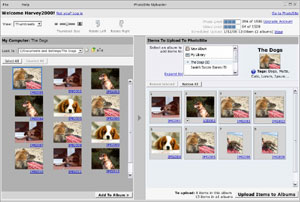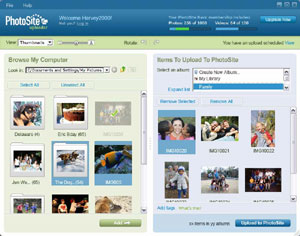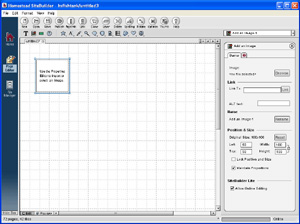INTUIT (www.intuit.com)

Intuit is most well-known for their work in small business and personal finance software for desktop and web, including Quicken, QuickBooks and TurboTax. As a company, Intuit has a customer-driven focus that inspires employees to "design for delight" and continues to expand their products and services. Most recently, Intuit has started working with leading healthcare companies to simplify the way millions of Americans manage their medical expenses.
Quicken Health Group - Quicken Health Expense Tracker

History: I started working at Intuit in the Quicken Health Group about 3 years ago, prior to the launch of our first product. Since then, I've been the lead designer on Quicken Health Expense Tracker, a web application that helps consumers understand and pay their healthcare expenses easily. The product successfully launched this year with three health plans including CIGNA and UnitedHealthcare.
My Work: As lead designer, I am responsible for the overall design vision for Quicken Health Expense Tracker. My work encompasses all aspects of the product for the full end-to-end customer experience, from marketing collateral and health plan integration through the application itself to the customer support interaction.
PHOTOSITE (site no longer active)
PhotoSite was an online photo-sharing community with over a half-million users. Focusing on the consumer market ranging from teens and parents to organizations and amateur/professional photographers, PhotoSite provided customizable web albums and easy-to-use photo management tools available via web browser and downloadable software. Launched in 2003 by Homestead Technologies, the product was acquired by United Online for $10M in 2005. Unfortunately, the division was closed in 2007 due to changing company priorities.
 PhotoSite 2.0 - Redesign of Online Photo/Video Management and Album Design Tools
PhotoSite 2.0 - Redesign of Online Photo/Video Management and Album Design Tools
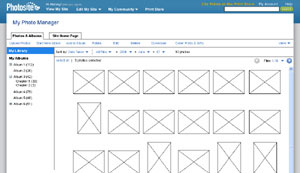
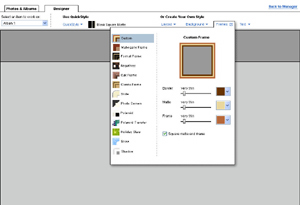
- Prototype
- Revised Prototype
- Photo Manager initial concepts
- Photo Manager visual design
- Designer palettes
- spec - pdf
Problem: PhotoSite's existing online tools for managing photos and designing albums had a limited feature set and were tied to an older xml-based backend architecture. We were looking to recreate all functionality that was in AlbumBuilder (our desktop software) on our website so users could manage their photos collection from any computer. The existing architecture could not support all the desired existing and proposed features efficiently. We needed to rethink the whole of the PhotoSite service.
Solution: Over a period of 3 months, I worked with a small cross-functional team consisting of UI design, visual design, engineering, marketing and support, to define the overall product vision from the front-end user experience to the the technical backend architecture. I was tasked with leading and managing the design process for this redesign that touched all aspects of the PhotoSite service. In addition, I was solely responsible for creating the online management and design experiences.
My Work: After brainstorming and working collaboratively with other designers, I created some initial flows and mockup concepts that we tested using a simple HTML-based prototype. Incorporating the usability test recommendations, I updated the prototype and sketched out a set of wireframes for all management and design screens. I worked closely with the engineering team to determine what technologies to implement within the service (AJAX, DHTML). I wrote several functional specification documents, organizing them into logical divisions according to how the engineering work was being allocated. These specs also incorporated managing and sharing videos which was being developed at another unit within the company and would be available for PhotoSite's use. After the specs and wireframes were reviewed by the project team, I started to work with the visual designer to come up with an overall visual design direction for the site, management and design tools and the user site. Throughout this, I was also managing one other designer who was responsible for the redesign of our user site navigation and layouts.
 PhotoSite Uploader - Downloadable Photo/Video Upload Client
PhotoSite Uploader - Downloadable Photo/Video Upload Client
Problem: We wanted to offer our users an easier way to get their photos from their cameras and computers to the PhotoSite service. Our existing software, AlbumBuilder, did not have a direct-connect-to-camera solution which is the most common use case for users with new photos. Since AlbumBuilder is based in the existing limited architecture, we felt we needed a new lightweight option for our users that would use the new architecture. However, we did not have any available resources to perform the UI, visual or development work.
Solution: After helping to refine the product requirements document (PRD), I was involved in finding, interviewing and selecting a design firm to whom we would outsource the UI and visual design. Development would be performed by an experienced desktop client team within the company.
My Work: As PhotoSite's UI design lead, I was responsible for reviewing all stages of the design process from initial concepts to interactive wireframes to final specification and graphic deliverables, ensuring that the design met with the requirements and our own standards. I acted as the UI design liaison between the design firm's interaction designers, the visual designer (separately contracted), and the internal engineering team, communicating with all three via email and conference calls.
 PhotoSafe - Introduction of Online Photo Management
PhotoSafe - Introduction of Online Photo Management
Problem: The CEO wanted to introduce a new product that revolved around secure backup of original photos. We needed to define the new product and how it would fit in with our current packages.
Solution: Working within a cross-functional team, we determined that the new product would be a repackaging of our existing offering that would be sold through a separate site, and secure backup would become a feature of our existing paid packages. Since the new product would require simple online photo management of archived photos, we would add these management tools to the site for all users.
My Work: I started by doing a competitive survey of other online photo management tools. Working within a limited timeline to launch, I defined a feature set that would meet our user's basic needs, created flows and wireframes for the management interface, and collaborated with a visual design contractor on the manager look and feel. I also consulted on the creation of the new product site, helping to determine the structure, design and content.
 Online Tool - Improving First-Time User Experience
Online Tool - Improving First-Time User Experience
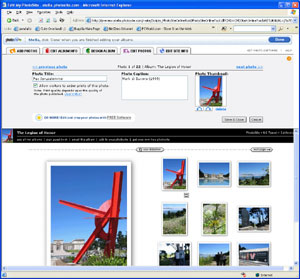
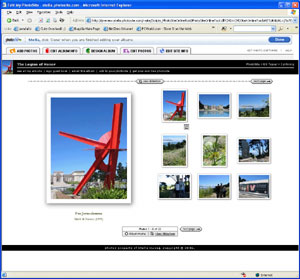
- screenshots of each panel
- revs of OT
- Sychronization flow
Problem: With all photo management and album creation happening within AlbumBuilder (desktop software), adoption rates were hovering around 25% of all registered users. We needed to improve adoption which was one of our main metrics. Adoption is defined as having uploaded at least one photo.
Solution: Downloading of AlbumBuilder seemed to be a significant barrier for most users according to support requests. From past customer surveys and usability tests, we knew that creating a web album was a very compelling and satisfying experience. We decided to create a simplified version of AlbumBuilder online that users would be driven to after registration.
My Work: I came up with some initial concepts that were reviewed by the whole team. Incorporating their feedback, I finalized designs and wrote functional specs for all aspects of the experience. I managed a visual design contractor to complete the visual design of the online app. I ran two rounds of usability testing, one before launch and one after launch. After the Online Tool was released, our adoption rates increased to over 50%.
HOMESTEAD TECHNOLOGIES (www.homestead.com)
Homestead Technologies is dedicated to providing easy-to-use tools and services for consumers and small businesses. Since 1996, over 12 million customers have used their award-winning software and hosting to create fully-featured websites for business, ecommerce and personal use without needing any programming or design skills. Homestead was acquired by Intuit Inc. for $170M in 2007.
 SiteBuilder LPX - Redesign of Flagship Software App
SiteBuilder LPX - Redesign of Flagship Software App
Problem: SiteBuilder was Homestead's website-building software application. Built upon an old business model that sold sponsored web elements for placement in the application and on webpages, SiteBuilder was due for a redesign.
Solution: Homestead was already working on a flexible backend system that would allow many applications to be generated on this platform, and the next-generation of SiteBuilder would be the first built. The basic feature set was determined from the previous version as it needed to support all existing functionality so this was a redesign of the technical backend and the interface.
My Work: I led the SiteBuilder redesign as the application was being rewritten from the ground up. Working from support feedback on the previous version, I simplified the toolbars, gave more real estate to the page work area, and included a built-in browser preview. The XML-driven layout engine allowed for greater flexibility, and allowing me to standardize several interaction "widgets" that could easily be reused. I managed two other UI designers to complete all functional specs on time, and I collaborated with two visual designers on the graphical interface. I performed usability testing on a working prototype and incorporated feedback for the beta launch. After an extensive beta period, the application was received by customers and press favorably, including a positive review in Business Week.
 Homestead Professional - Box Software and CD Interface
Homestead Professional - Box Software and CD Interface


Problem: Homestead was creating a new product, Homestead Professional, from the ground up targeting small-office / home-office (SOHO) customers who wanted to build a web presence. Homestead Professional was a repackaging of the existing software and hosting into a paid subscription service with a new marketing website and business-oriented features like domains, site promotion and email accounts. in addition to traditional online advertising and email marketing campaigns, we wanted to try different ways to drive potential customers to sign up.
Solution: We wanted to try selling the service as "box software" which would compete with other products like FrontPage and HomeSite. The product team was tasked with creating the packaging collateral as well as the installation CD. This product was initially sold on Amazon in the web publishing software category. The CD would allow the user to install the software, signup for the service and get additional support.
My Work: I created the initial concept, flow and screens for the installation CD interface and the software installer, and I also wrote the functional spec. I worked closely with a visual designer to produce final production graphics for the CD and installer which were inspired by the box art. Then I developed, tested and deployed the interactive CD interface using DemoShield.
My initial work for this CD became the basis for all future CDs produced for Homestead products. I developed several different CDs based on this interface, including CDs for customer support, free Homestead trial, Homestead/PhotoSite combined product trials, and installation for new versions of the core Homestead software.
 Homestead Professional - Registration Process
Homestead Professional - Registration Process
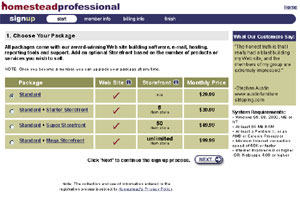
Problem: When first launched, the Homestead Professional registration process was long and had several steps for the user to complete. The user dropoff from the start to finish was very high with less than 3% completing the process.
Solution: Through a series of A/B tests, we reduced the amount of information necessary to sign up for an account and simplified key pages.
My Work: I was a key member of the team determining the content of the A/B tests. In a series of three test rounds, we streamlined the registration process and reduced the number of pages by 50%. I also simplified the design of the Choose Package page which was the first page in the registration process.
